Piping Plover
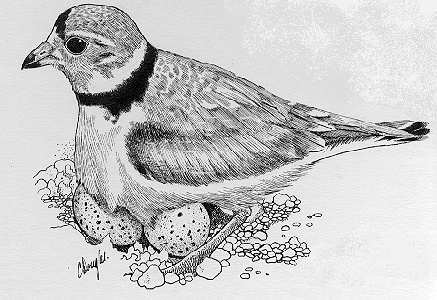
Status cause: Habitat loss or degradation due to prime habitat along coastal beaches where commercial, residential and recreational development commonly occurs. Nest disturbance and predation are also factors due to people and animals.
Where found: Found from Montana to Maine in the north,
Texas to Florida in the south and along the entire east coast.
![]()
Kirtland's Warbler
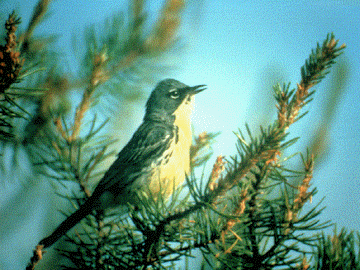
Status cause: Limited habitat and cowbird parasitism (cowbirds lay their eggs in warbler nests and the warblers then raise cowbird young instead of their own.
Where found: Jack pine forest area in Michigan.
![]()
Whooping Crane

The Whooping Crane is one of the largest North American birds and one of the most seriously endangered. It stands nearly 1.5 m (5ft) tall and with a 2.3m (7.5 ft) wingspread. The Whooping Crane is a long necked, long legged bird of prairie and marsh. The long, powerful bill is used for killing snakes, frogs, and other small animals for food. Adults have completely white plumage, except for black primary feathers on the wings, black legs, and bare red areas on the head. They are know for their loud whooping cries, which can be heard as the birds migrate between winter and summer homes. After elaborate courtship rituals, cranes build a nest of vegetation on moist ground. Usually two eggs are laid, but only one chick survives to fly south for winter.
Whooping cranes formerly occupied widespread breeding areas in Canada and the northern United States, but their numbers have diminished greatly. The bird is now protected by law on its breeding grounds near Great Slave in Canada, and its wintering grounds in the Aransas Wildlife Refuge in Texas, and all along its migration route.
![]()
Bald Eagle

The Bald Eagle, the national bird of the United States, ranges widely in North America, from Alaska to Florida, with the largest coming from the northern parts of the range. The name bald, often thought to be a misnomer, does not imply a lack of feathers, but is derived from an obsolete word meaning marked with white, as in piebald. Young birds of this species lack the white head and tail of the adults, which take four to five years to attain. Compared to other eagles, the Bald Eagle is a relatively clumsy hunter and fisher, and for its prey relies heavily on dead or injured fish, or those that come to shallow water to spawn. It also steals fish from the osprey when the smaller bird has captured a live fish, harassing it in the air until the osprey drops the fish, whereupon the eagle snatches it.
After the breading season the northern birds migrate south,
whereas many Florida eagles wander northward.
![]()
Glaucous Macaw
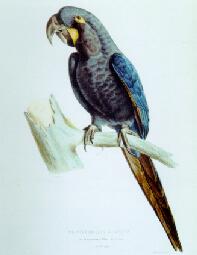
The Glacous Macaw lives in open and partially open areas
with yatay palms. Also along rivers and marshlands with trees and palms.
The only place that this bird has been seen is in Hawaii. Their diet consists
of yatay palms, fruits, nuts, berries, and vegetables. For more information
on the Glacous Macaw visit http://www.arndt-verlag.com.
![]()
Maui Parrotbill
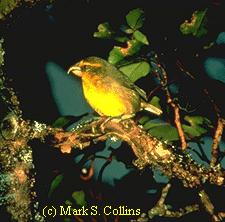
The Maui Parrotbill has only been seen on the island of
Maui, in Hawaii. These birds live where heavy undergrowth is present.
Their diet consists of fruits, berries, and vegetables. For more
information on the Maui Parrotbill visit http://www.aloha.net/~hinhp/pbill.htm.
![]()
Thick-Billed Parrot

The Thick-billed Parrot (a.k.a. the "cold weather" or
"snow" parrot) once lived in the American southwest and central America.
Now these birds are found only in the Sierra Madre Occidental mountains
of Mexico. The cause of this birds endangerment is the loss of habitat
due to the logging of pine forests. They are strong flyers that are
adapted to forage for Pinus spp. cones and seed. For more information
on the Thick-billed Parrot visit http://www.kaytee.com/discovery/.
![]()
California Condor
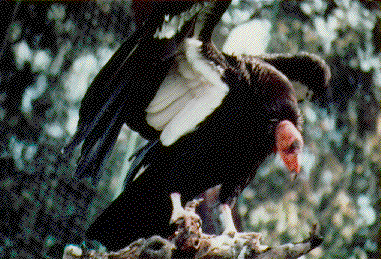
The California Condors habitat is usually in a cave, on
a cliff, or in a crevice along some boulders. The average weight
of this type of condor is 20 to 24 pounds. Their diet consists of
large deer and buffalo carcasses. They have become endangered because
of shootings, poisonings, power lines, and loss of habitat. There
is good news for these condors, in 1982 there were only 22 condors of this
species alive, but today there are currently 120 California Condors alive
and well. For more information on the California Condor visit http://www.peregrinefund.org/CACondor.html
![]()
Home Page Zoo News Zoo Staff History Reptiles Birds Mammals
Created on December 1, 1998